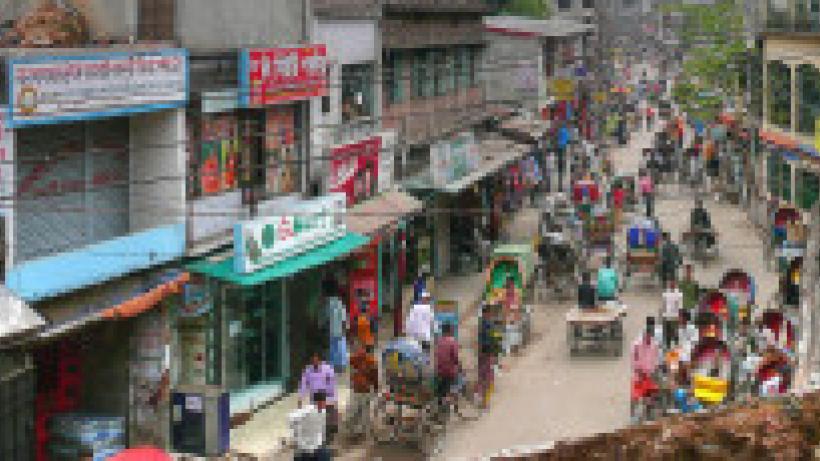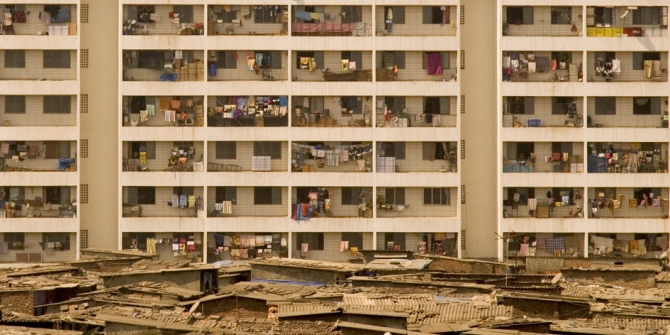
SDG 11: Supporting the delivery of cities that work for all
Continuing with our series on the SDGs and the new global agenda, Shabana Shiraz considers how Goal 11, which focuses specifically on urban development can aid existing efforts across South Asia to tackle inequality and make cities safer and more sustainable.
This post forms part of a cross-blog series on the 2030 Agenda for Sustainable Development run by the IGC, Africa at LSE, and South Asia at LSE blogs. View more posts in this series.
The inclusion of an urbanisation goal in the post-2015 agenda sent a wave of cheer among hardcore advocates who have been campaigning for the achievement for three years and those in the international community who have accepted the importance of addressing urbanisation and development in tandem. Most importantly, it marked the unanimous recognition of the urban future that the developing world is swiftly marching towards. SDG 11 is broadly worded and ambitious:“make cities and human settlements inclusive, safe, resilient and sustainable”. The ten indicators that try to address everything from providing affordable housing, to universal access to public transport, to reducing the per capita environmental impact of cities, may as well be termed the Holy Grail for rapidly urbanising developing countries.
A tale of two cities in one
The South Asian (SA) region is home to five out of the twenty three mega cities (i.e. those with a population greater than 10 million) around the world. They have a growth rate of more than 2% per year – amongst the highest in the world, and include the three most densely populated cities in the world. While the Indian cities of Mumbai and Delhi are in line to gain a place among the top 20 urban economies of the world by 2025, Dhaka and Chittagong – with their concentration of garment and real estate industry – are responsible for sustaining a growth rate of more than 6 percent in Bangladesh. This makes for excellent marketing material, highlighting the competitiveness of South Asian cities. Unfortunately, countries like Bangladesh and Nepal are also leading trends in urban poverty. More than 50 percent of their urban populations live in informal settlements, often referred to as ‘slums’ or ‘shanty towns’, with no access to basic social and physical infrastructure such as health, education, water, sanitation and transportation. Rapid, unplanned urbanisation has rendered SA cities spaces where multiple deprivations and inequalities are reflected in everyday life, be it in access to water, transportation, health and educational facilities or political participation. This has locked cities in a perennially dichotomous states of contrasting realities, characterised by rapid economic growth on the one hand and multiple deprivations on the other.
Efforts have been made to change this. The idea of sustainability and resilience advocated by the international community through SDG 11 is very well reflected in the urban policy discourse in SA cities today. The BRT (bus rapid transit) systems implemented in the cities of Lahore and Ahmedabad are examples of policy success at achieving sustainability through integration of land use and transport systems, reducing both travel times and greenhouse gas emissions. Dhaka and Surat are undertaking multi-disciplinary research on reducing vulnerability and increasing the resilience of urban systems towards anticipated climate change risks. Moreover, all SA countries have made an effort to decentralise as a part of cross-cutting governance reforms to further the agenda of sustainability and resilience along with establishing democratic institutions for participation since the 2000s. Despite these efforts, the status quo of urban inequality and poverty persists. Land markets are still polarised in Mumbai and the urban poor in the city of Dhaka end up paying far more than their counterparts for water supply.

Transforming urban realities
One of the reasons for this is that inclusiveness in only covertly addressed in the existing urban policy discourses and equity is hardly ever a priority. Local politics that favour powerful minorities are embedded into the urban fabric to such an extent that the most benign visions of urban renewal, sustainability, resilience and most recently smart cities and green economies have lead to misconstrued policy goals that favour a select few.
In such situations, can an urban SDG with a focus on inclusiveness be a game changer in introducing transformative change in the rapidly urbanising South Asian cities? Considering the MDG experience, one can say that a lot depends on the way SDGs are implemented. A ray of hope can be found in the recommendations of the recently concluded South Asian consultation on the post 2015 development agenda that advocates an implementation strategy focused on a rights based approach, embedded in equity and monitored by robust data. Together with the emphasis on urban inclusion, there is the potential that the urban SDG could help cities to break free from the strict dichotomy of economic growth and inequality. The beauty of the urban SDG lies in its ability to guide the urban visions in the diverse contexts currently existing in the SA region. Be it the vision of recovery in Afghanistan and Nepal or that of sustained economic growth in India, Pakistan and Bangladesh, an urban SDG provides elements that promote the mainstreaming of equity within existing policy priorities.
The SDG also creates conditions where existing and future multilateral support to fuel economic growth in SA cities would have to be more sensitive towards the goal of achieving equity, inclusiveness, resilience and sustainability. Developing country-specific standards for each of the 10 individual targets not only by the international community, but also national civil society organisations and citizens shall go a long way in converting the vision of equitable cities into a reality. Participatory governance platforms and social accountability tools like citizen report cards have already been utilised in India, Bangladesh and Nepal to collect data on aspects like inclusiveness in supply of basic urban services. These tools need to be further strengthened to provide complementary environments for implementation of the urban SDG.
An urban SDG thus holds great promise for SA cities in terms of shifting the focus of urban policy discourse which has been on promoting competitiveness and economic growth to one on inclusiveness. It has the potential to meddle with the existing power dynamics that are at play and may offer resistance to a comprehensive implementation of such an agenda. Politically nuanced approaches that take cognisance of such power dynamics and restructure the same to suit the implementation of an urban SDG will be of importance.
This article gives the views of the author, and not the position of the IGC.
This post forms part of a cross-blog series on the 2030 Agenda for Sustainable Development run by the IGC, Africa at LSE, and South Asia at LSE blogs. View more posts in this series.

